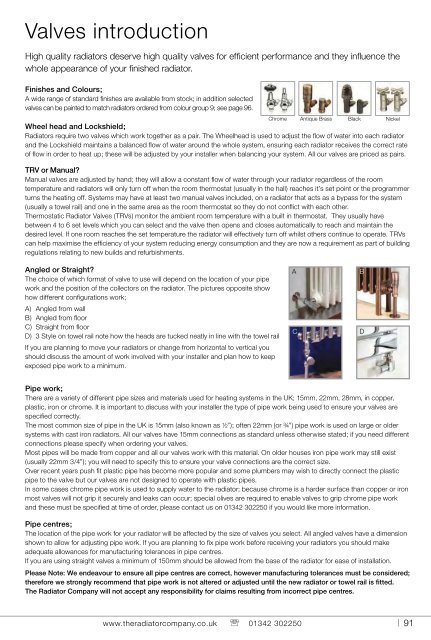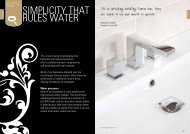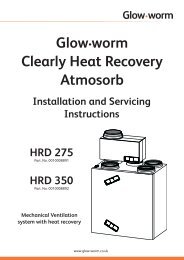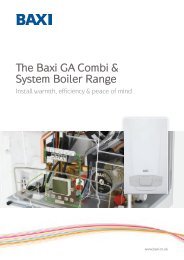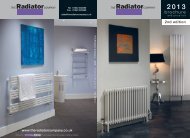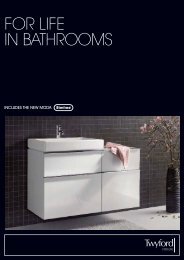2012 - Sussex Plumbing Supplies
2012 - Sussex Plumbing Supplies
2012 - Sussex Plumbing Supplies
You also want an ePaper? Increase the reach of your titles
YUMPU automatically turns print PDFs into web optimized ePapers that Google loves.
Valves introduction<br />
High quality radiators deserve high quality valves for efficient performance and they influence the<br />
whole appearance of your finished radiator.<br />
Finishes and Colours;<br />
A wide range of standard finishes are available from stock; in addition selected<br />
valves can be painted to match radiators ordered from colour group 9; see page 96.<br />
Chrome Antique Brass Black Nickel<br />
Wheel head and Lockshield;<br />
Radiators require two valves which work together as a pair. The Wheelhead is used to adjust the flow of water into each radiator<br />
and the Lockshield maintains a balanced flow of water around the whole system, ensuring each radiator receives the correct rate<br />
of flow in order to heat up; these will be adjusted by your installer when balancing your system. All our valves are priced as pairs.<br />
TRV or Manual?<br />
Manual valves are adjusted by hand; they will allow a constant flow of water through your radiator regardless of the room<br />
temperature and radiators will only turn off when the room thermostat (usually in the hall) reaches it’s set point or the programmer<br />
turns the heating off. Systems may have at least two manual valves included, on a radiator that acts as a bypass for the system<br />
(usually a towel rail) and one in the same area as the room thermostat so they do not conflict with each other.<br />
Thermostatic Radiator Valves (TRVs) monitor the ambient room temperature with a built in thermostat. They usually have<br />
between 4 to 6 set levels which you can select and the valve then opens and closes automatically to reach and maintain the<br />
desired level. If one room reaches the set temperature the radiator will effectively turn off whilst others continue to operate. TRVs<br />
can help maximise the efficiency of your system reducing energy consumption and they are now a requirement as part of building<br />
regulations relating to new builds and refurbishments.<br />
Angled or Straight?<br />
The choice of which format of valve to use will depend on the location of your pipe<br />
work and the position of the collectors on the radiator. The pictures opposite show<br />
how different configurations work;<br />
A) Angled from wall<br />
B) Angled from floor<br />
C) Straight from floor<br />
D) 3 Style on towel rail note how the heads are tucked neatly in line with the towel rail<br />
If you are planning to move your radiators or change from horizontal to vertical you<br />
should discuss the amount of work involved with your installer and plan how to keep<br />
exposed pipe work to a minimum.<br />
A<br />
C<br />
B<br />
D<br />
Pipe work;<br />
There are a variety of different pipe sizes and materials used for heating systems in the UK; 15mm, 22mm, 28mm, in copper,<br />
plastic, iron or chrome. It is important to discuss with your installer the type of pipe work being used to ensure your valves are<br />
specified correctly.<br />
The most common size of pipe in the UK is 15mm (also known as ½”); often 22mm (or ¾”) pipe work is used on large or older<br />
systems with cast iron radiators. All our valves have 15mm connections as standard unless otherwise stated; if you need different<br />
connections please specify when ordering your valves.<br />
Most pipes will be made from copper and all our valves work with this material. On older houses iron pipe work may still exist<br />
(usually 22mm 3/4”); you will need to specify this to ensure your valve connections are the correct size.<br />
Over recent years push fit plastic pipe has become more popular and some plumbers may wish to directly connect the plastic<br />
pipe to the valve but our valves are not designed to operate with plastic pipes.<br />
In some cases chrome pipe work is used to supply water to the radiator; because chrome is a harder surface than copper or iron<br />
most valves will not grip it securely and leaks can occur; special olives are required to enable valves to grip chrome pipe work<br />
and these must be specified at time of order, please contact us on 01342 302250 if you would like more information.<br />
Pipe centres;<br />
The location of the pipe work for your radiator will be affected by the size of valves you select. All angled valves have a dimension<br />
shown to allow for adjusting pipe work. If you are planning to fix pipe work before receiving your radiators you should make<br />
adequate allowances for manufacturing tolerances in pipe centres.<br />
If you are using straight valves a minimum of 150mm should be allowed from the base of the radiator for ease of installation.<br />
Please Note: We endeavour to ensure all pipe centres are correct, however manufacturing tolerances must be considered;<br />
therefore we strongly recommend that pipe work is not altered or adjusted until the new radiator or towel rail is fitted.<br />
The Radiator Company will not accept any responsibility for claims resulting from incorrect pipe centres.<br />
www.theradiatorcompany.co.uk ' 01342 302250<br />
91


